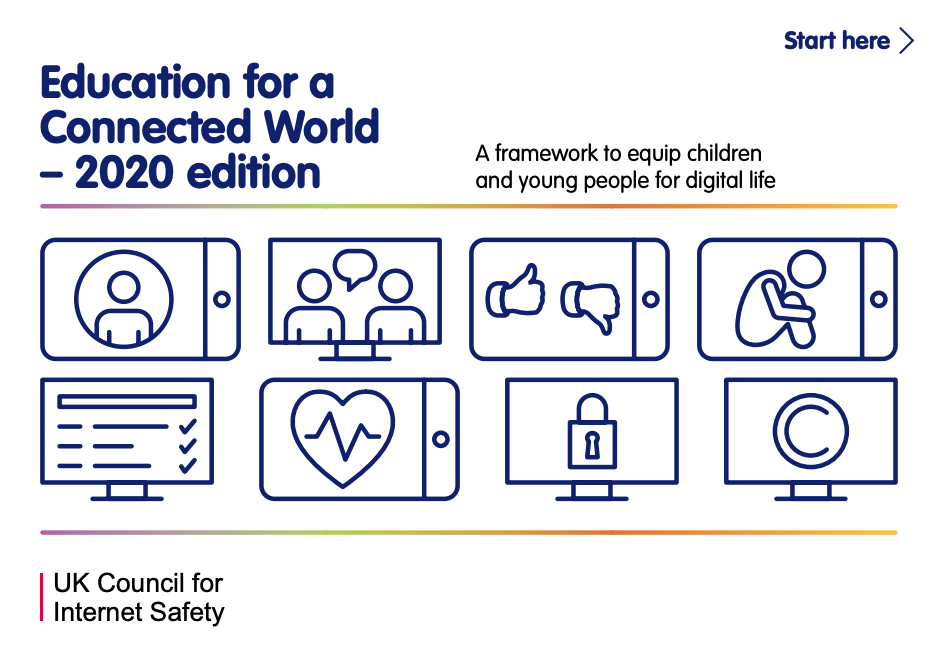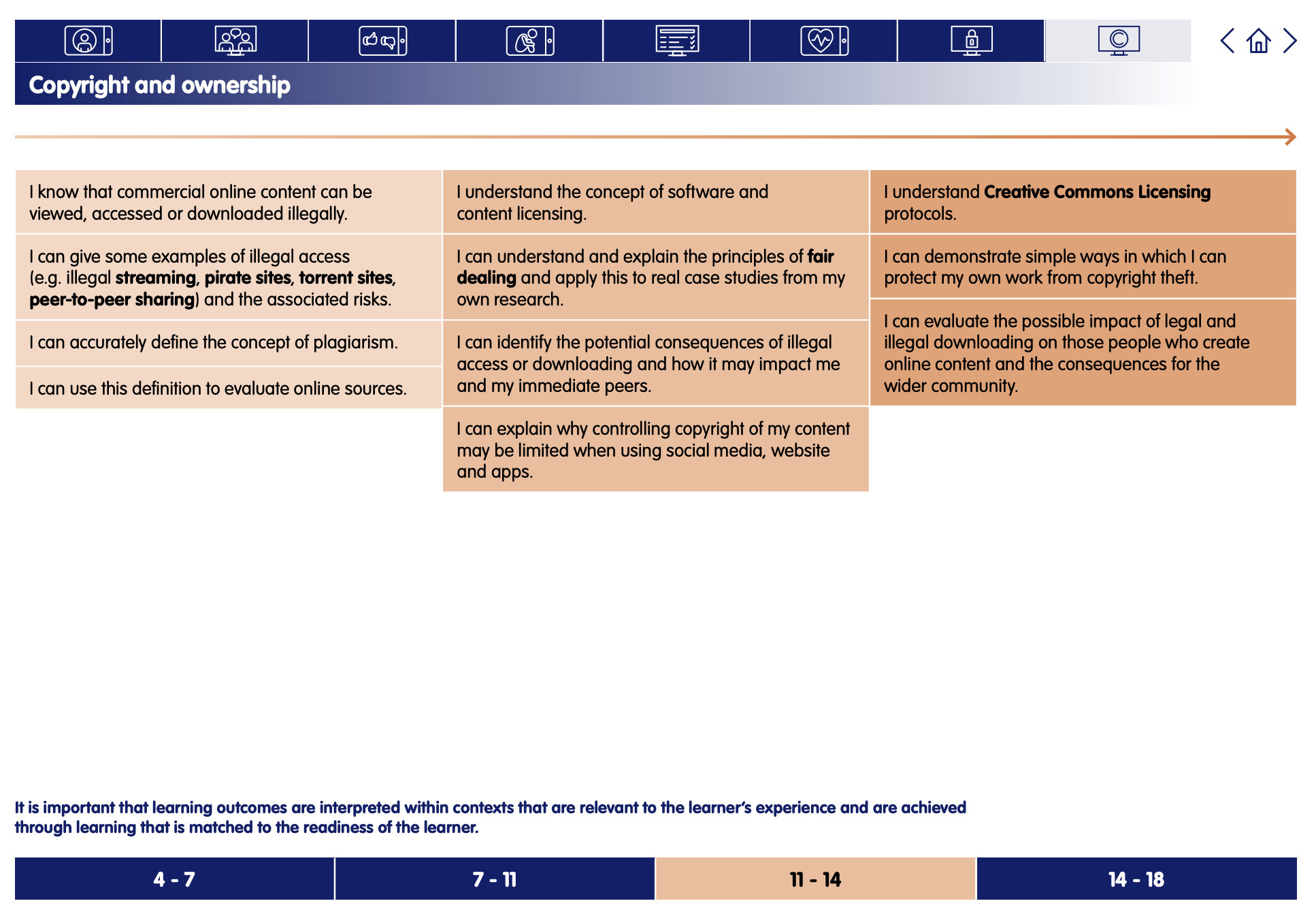Copyright and Fair Dealing
Digital Literacy and Online Safety (Y8) - Lesson 6
A note about this lesson

This lesson is taken from Common Sense Education’s excellent Digital Citizenship curriculum. Their resources are shared for free under A Creative Commons Attribution- NonCommercial- NoDerivatives 4.0 International License.
You can find the original resources HERE.
Objectives
Lesson 1 - My Media Use: A Personal Challenge
Lesson 2 - Big Big Data
Lesson 3 - The Power of Digital Footprints
Lesson 4 - My Social Media Life
Lesson 5 - Upstanders and Allies
Lesson 6 - Copyright and Fair Dealing
Links to Education for a Connected World.
This lesson from Common Sense Media's Digital Citizenship curriculum links to the following strands from the Copyright and ownership section of the Education for a Connected World framework.
Note: This lesson contains videos hosted on YouTube and Vimeo. You may need to get permission to view them.
Invite volunteers to share their thoughts. Help learners connect their feelings to a shared definition of fairness: that when you work hard on something you create, you deserve credit for it. Emphasise that:
- It's unfair but also illegal to use other people's copyrighted writing, music, pictures, videos or artwork without permission or citing them.
- There are laws in place in the UK that protect your creative work. (Note: you get copyright protection automatically and do not need to apply for it.)
- What is copyright?
- Why is copyright important?
Invite learners to share their answers and summarise their responses by defining copyright as the legal protection that creators have over the things they create. (Slide 4)
Say: To help you answer this question, we are going to look at four of the most common exceptions that are considered fair dealing. They are organised in a square to help you remember them.
As needed, provide examples for each exception as you go through them:
- Parody: You are making a video for your Aunt as she is turning 40. Your Aunt likes adventurous sports like skiing and skydiving, so you include lots of clips of stunts from James Bond movies and superimpose her face onto James Bond's face. You are sure this will get a lot of laughs at her surprise birthday party! Using the James Bond movie clips is not a copyright infringement as you are only using them for some good-humoured fun.
- Study (non-commercial research and study): If you are writing a research paper and want to use a quote from an article or book to support your ideas, this is permitted under fair dealing as long as you provide a citation for the author/work. Using informational works such as news, magazines, scholarly books and articles for non-commercial research and study is also allowed under fair dealing.
- Review or Criticism: You are making a video review about new films you have seen in the cinema. You include a clip of a film that you downloaded from Instagram and post your video on the school news Facebook page. The film clip can be fair dealing as it is relevant to your blog and the film is already available to the public.
- Note: It is an essential prerequisite of fair dealing for the purpose of criticism or review that the copyrighted work is available to the public (for example, by means of an authorised performance, exhibition, playing or showing of the work in public). If the copyrighted work is unpublished, or unavailable to the public, it cannot be fair dealing under the criticism or review exemption. For more information, see CopyrightUser.org.
- Reporting: Your local leisure centre has been in the press recently due to a spate of vandalism. The local newspaper wants to interview you, as you are a young person who has been campaigning on social media, speaking out against the vandalism. You do a telephone interview, but when the article appears in the newspaper, the reporter has also included one of your photos. They have also used one of your videos of the vandalism (from your Twitter feed) on their website. They do not give you credit for the photo, and therefore this would not be fair dealing, as a photograph cannot be reproduced for the purpose of reporting current events. However, as the video is used for reporting current affairs, it would be considered fair dealing.
Project Slide 9 and have a learner read aloud the example. After one minute, ask learners to give a thumbs-up or thumbs-down and call on two people to briefly explain their thinking. Prompt learners to refer back to the four exceptions that count as fair dealing and ask: Is it fair ... and square?
Explain that this example probably isn't fair dealing because although Maya is only using part of the logo, it's for advertising and she plans to make a profit. Therefore it does not fall under any of the four fair dealing exceptions.
- Example No. 2: Not fair dealing. Learners are using the song for mood but not transforming or reworking the song in any way.
- Example No. 3: Most likely fair dealing. Eva is critiquing and commenting on unrealistic expectations about appearance that some magazines promote. It could even be thought of as a parody.
- Example No. 4: No, it is not fair dealing. But it is OK to use it in this example because the image is part of the public domain.
Note: This section includes a music video by DJ Earworm, which is composed of clips from other popular music videos. Review this video in its entirety before showing it to learners. If you are comfortable sharing only a segment of the video, feel free to do so.
Define sampling as reworking a portion of a song or sound recording into a new composition. (Slide 13) Note that sampling is a foundation for hip-hop music in which drum breaks or other sounds are sampled, looped and rapped to. Explain that musicians often get permission from the original artist before they sample, or they use samples in the public domain … but not always.
Invite learners to respond. Help learners connect their ideas to the four exceptions of fair dealing: parody, study, criticism or review, and reporting. Explain that, as with any creative work that involves fair dealing, it depends on the situation.
Read the bullet points aloud and explain that learners will watch the video and then work in pairs or groups to complete the graphic in Part 3 of their Fair and Square handout. Show DJ Earworm - Summermash 2020 video.
Call on groups to share their "Final Decision" responses. Use the Teacher Version for guidance. (For fun, you can play judge and actually make a call as to whether or not you believe it's fair dealing.) Explain that there are valid arguments on both sides.
- There is no statutory definition of fair dealing -- it will always be a matter of fact, degree and impression in each case.
- When in doubt, the safest choice if you want to use copyrighted work is to get permission from the author. This means reaching out and emailing them, calling or writing a letter. It's also the responsible thing to do as a digital citizen as there is no statutory definition for fair dealing. You might be surprised by what they say!
- But you also can also check whether the work falls under the four permitted exceptions for fair dealing. Whether you claim fair dealing or not, make sure to always give credit to the creator of the original work.


